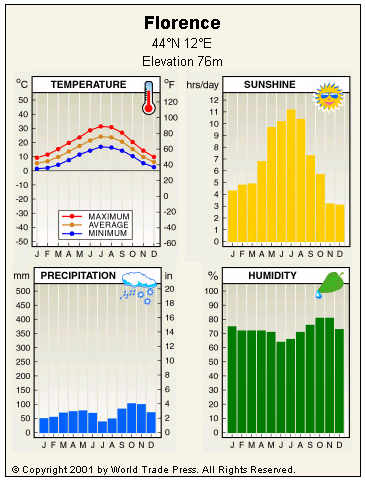Country Snapshot: Climate Overview
Italy is a southern European country with coastlines on the Adriatic Sea to the east, the Ionian and Mediterranean seas to the south, and the Tyrrhenian and Ligurian seas to the west. It has an emblematically Mediterranean climate along most of its coast, and a humid subtropical climate along the Aegean coast. The country’s interior has a marine west coast climate, while the northern mountain region is much colder and its climate can be classified as tundra.
Seasons
Winter (December to February) is mild and rainy. Northern regions can be affected by the bora, a gusty wind that brings very cold air from central Europe.
Spring (March to May) is warm and dry.
Summer (June to August) is hot and dry. On some occasions the entire country will experience high temperatures and humidity due to the warm sirocco winds that originate over northern Africa. These spells usually conclude with heavy rains and thunderstorms.
Autumn (September to November) is dry until around October when the winter rains begin.
Regional Variations
Italy consists of the northern Alpine region, the Po Valley plain, and the central and southern regions.
The Alpine region, where some mountains rise above 3,500 meters (11,500 feet), tends to have rainy summers and cold winters. Temperatures in Bolzano range from -7–1°C (19–34°F) in January to 10–22°C (50–72°F) in July. Rain is heaviest in August, with 103 millimeters (4.1 inches) of rainfall, while the driest month is January with 28 mm (1.1 in).
The Po Valley plain, which extends from Turin to Venice, is a flat and low-lying region with hot summers and cold winters. In Venice, temperatures range from -1–6°C (30–43°F) in January to 18–28°C (64–82°F) in July. Rainfall is generally consistent throughout the year, with 57 mm (2.2 in) in February and 90 mm (3.0 in) in November. During the winter, fog, frost, and snow are common. Summer and autumn often have rainfall in the form of thunderstorms.
The central and southern region includes the mountainous peninsula as well as the islands of Sardinia and Sicily. Snow is rare but does occur, although generally temperatures range from 7–15°C (45–59°F) in January to 21–31°C (70–88°F) in August. Rainfall varies significantly according to season, with 4 mm (0.2 in) in July and 104 mm (4.1 in) in October. The east coast, along the Adriatic, experiences less rainfall than the west coast.
Copyright © 1993—2024 World Trade Press. All rights reserved.

 Italy
Italy 
